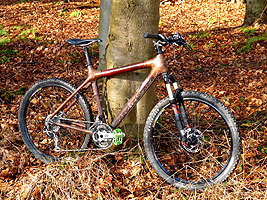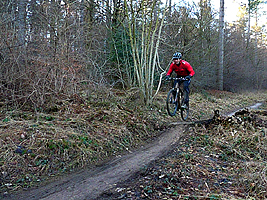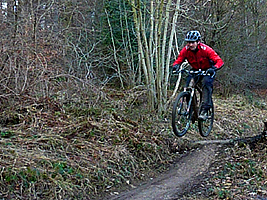Thought I'd do a list of kit that I've used that works. Hope you find it vagely useful!
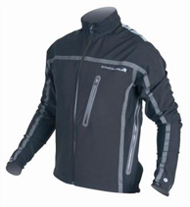 Endura Stealth Jacket 07/08 – the first waterproof soft-shell I know of. Great bit of kit, breathes reasonably well even though I sweat almost as soon as I start riding... It's got a thin fleece lining, so I wouldn't wear it on warm days, but the rest of the time it's quite versatile. You can wear it with just a base layer, or if it's really cold with a mid-layer as well. 2 sets of vents make it cool enough as you get warmer. Only a chest & back pocket, but this has been enough for me so far. The back pocket will hold just enough to get by on short rides where you may not want to take a backpack. It's still going strong & still 100% waterproof. Newer versions have more pockets, so even better. Only regret is that I went for red instead of my usual preference for dependable black! The blue looked quite good but wasn't in stock at the time
Endura Stealth Jacket 07/08 – the first waterproof soft-shell I know of. Great bit of kit, breathes reasonably well even though I sweat almost as soon as I start riding... It's got a thin fleece lining, so I wouldn't wear it on warm days, but the rest of the time it's quite versatile. You can wear it with just a base layer, or if it's really cold with a mid-layer as well. 2 sets of vents make it cool enough as you get warmer. Only a chest & back pocket, but this has been enough for me so far. The back pocket will hold just enough to get by on short rides where you may not want to take a backpack. It's still going strong & still 100% waterproof. Newer versions have more pockets, so even better. Only regret is that I went for red instead of my usual preference for dependable black! The blue looked quite good but wasn't in stock at the time
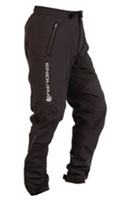 Endura Venturi eVent jacket & trousers – eVent seems to live up to the hype. The theory is that it breathes without body heat. It's as or more breathable than most other materials, but feels better than some when you get a bit cold. Also seems reasonably tough & hard wearing. I recently did put a small tear in the knee, but this was a heavy fall with a huge pack on ...gaffer tape required! Well thought out, 2 side pockets plus a back pocket. Still waterproof after 2½ years & has only been re-treated 'just in case'.
Endura Venturi eVent jacket & trousers – eVent seems to live up to the hype. The theory is that it breathes without body heat. It's as or more breathable than most other materials, but feels better than some when you get a bit cold. Also seems reasonably tough & hard wearing. I recently did put a small tear in the knee, but this was a heavy fall with a huge pack on ...gaffer tape required! Well thought out, 2 side pockets plus a back pocket. Still waterproof after 2½ years & has only been re-treated 'just in case'.
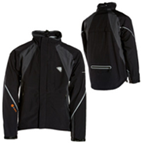 Comments for the jacket as for the trousers. It has more pockets than the Stealth. Great jacket, shame I stupidly lost it...
Comments for the jacket as for the trousers. It has more pockets than the Stealth. Great jacket, shame I stupidly lost it...
- Paramo Velez Adventure Lite Smock – got this to kind of replace the eVent jacket. This is the first Paramo that isn't too hot for biking in. I thought I'd try it as Paramo stuff lasts ages; many people have Paramo gear that's been going for over 10 years.
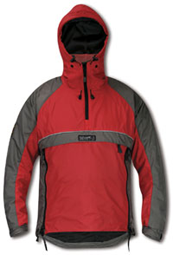 Reason for this is that the waterproofing is down to a layering system rather than a membrane. If it loses it's waterproofing a bit you just re-proof with Nikwax TX10 to bring back the performance. The smock design might not suit everyone, and there is only a chest pocket & a kind of one piece hand-warmer pocket accessed through the side vents, but I always have plenty of space somewhere, so lack of pockets hasn't been an issue for me. It's still a warmish garment for cycling, so can be worn with just a base-layer, but if it gets too hot the afore-mentioned side-vents allow for a fair bit of cooling. Not really for the summer, but the rest of the year it's great. First impressions were that the sleeves were on the short side for biking, but in practice this hasn't been a problem. The Velcro cuffs seem to do a good job. The other difference with Paramo is the feel, their stuff is really soft to wear
Reason for this is that the waterproofing is down to a layering system rather than a membrane. If it loses it's waterproofing a bit you just re-proof with Nikwax TX10 to bring back the performance. The smock design might not suit everyone, and there is only a chest pocket & a kind of one piece hand-warmer pocket accessed through the side vents, but I always have plenty of space somewhere, so lack of pockets hasn't been an issue for me. It's still a warmish garment for cycling, so can be worn with just a base-layer, but if it gets too hot the afore-mentioned side-vents allow for a fair bit of cooling. Not really for the summer, but the rest of the year it's great. First impressions were that the sleeves were on the short side for biking, but in practice this hasn't been a problem. The Velcro cuffs seem to do a good job. The other difference with Paramo is the feel, their stuff is really soft to wear
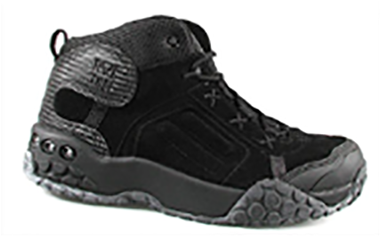 5-10 Impact High/Low '06 – most people know how good 5-10 shoes are. They use tacky rubber, same as climbing shoes on the soles, so they grip flat pedals like nothing else. Only thing to add is that they're still going now with no signs of giving up. The newer ones are synthetic uppers, not heard any negatives about this so far. The main reason why I have 2 pairs is that at the time there seemed to be some doubt as to whether they would keep making them, so I ordered a second lot. They proved so popular that it looks likely they'll be made for some time into the future. The Lows are a bit more comfy, I have weird feet with angular bony bits that make the left shoe slightly less comfy on the High's. I found the High's could be waterproofed reasonably well with Grangers or similar.
5-10 Impact High/Low '06 – most people know how good 5-10 shoes are. They use tacky rubber, same as climbing shoes on the soles, so they grip flat pedals like nothing else. Only thing to add is that they're still going now with no signs of giving up. The newer ones are synthetic uppers, not heard any negatives about this so far. The main reason why I have 2 pairs is that at the time there seemed to be some doubt as to whether they would keep making them, so I ordered a second lot. They proved so popular that it looks likely they'll be made for some time into the future. The Lows are a bit more comfy, I have weird feet with angular bony bits that make the left shoe slightly less comfy on the High's. I found the High's could be waterproofed reasonably well with Grangers or similar. 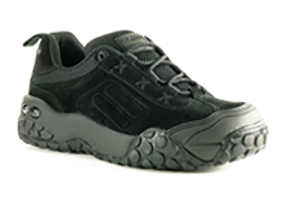 If they do get wet, dry them out fairly soon, as almost every shoe other than the clip-in types have a midsole made of compressed & glued cardboard, or something similar
If they do get wet, dry them out fairly soon, as almost every shoe other than the clip-in types have a midsole made of compressed & glued cardboard, or something similar
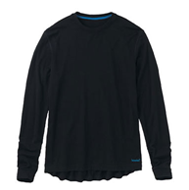 howies merino base layers – many reasons why I use these; they're still reasonably warm if they get wet, they breathe better than anything else by a long way, they never smell bad like synthetics, they keep you warm in the winter & cool in the summer. The merino fibres are naturally resistant to bacteria & they can absorb a lot of liquid before they feel damp. howies merino is about as good as it gets, so there's no hint of itchiness
howies merino base layers – many reasons why I use these; they're still reasonably warm if they get wet, they breathe better than anything else by a long way, they never smell bad like synthetics, they keep you warm in the winter & cool in the summer. The merino fibres are naturally resistant to bacteria & they can absorb a lot of liquid before they feel damp. howies merino is about as good as it gets, so there's no hint of itchiness
- howies merino mid layer – same comments as for the base-layers, just a warmer version. They have thumb loops to make it easier to put a jacket on
- howies long way home shorts & merino liner – not much to say, the shorts are comfy, the liners are really comfy. It looks very much like they were made by Endura, which is a good thing, but they were quite pricey. Bit of an irrelevant review as they don't seem to sell them any more. They do have a habit of reviving stuff though...
- Endura Humvee & Singletrack shorts – really well made, Endura stuff generally is. They have plenty of pockets & the Singletrack shorts came with liners. Most shorts do the job, but Endura seem to do it pretty well. Best to try on before you buy, as good fit is important
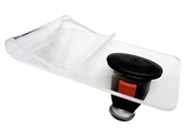 Rixen Kaul Klickfix Mini Map Holder – the Klickfix system is used to attach various things to the handlebars, but the map holder is the only thing of interest to me. The map holder is great, helps avoid missing a turning because you have the map in sight all the time. It's made of folded perspex & is A6 size. I use Memory Map & then laminate the maps. Satmap seem to have borrowed the same attachment system for their GPS unit. The mount rotates 90 degrees to fit bars or stems. The similar Polaris MapTrap is a bit cheaper & has an identical looking map holder. Not sure if it's as versatile in fitting though. I reckon I'd struggle to fit it around a bike computer & light as easily as with the Rixen Kaul version
Rixen Kaul Klickfix Mini Map Holder – the Klickfix system is used to attach various things to the handlebars, but the map holder is the only thing of interest to me. The map holder is great, helps avoid missing a turning because you have the map in sight all the time. It's made of folded perspex & is A6 size. I use Memory Map & then laminate the maps. Satmap seem to have borrowed the same attachment system for their GPS unit. The mount rotates 90 degrees to fit bars or stems. The similar Polaris MapTrap is a bit cheaper & has an identical looking map holder. Not sure if it's as versatile in fitting though. I reckon I'd struggle to fit it around a bike computer & light as easily as with the Rixen Kaul version
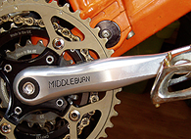 Middleburn chain rings & RS7 cranks – lightweight cranks with a lifetime guarantee! The RS7's are guaranteed for dirt jumping & DH! If you want to go even lighter they do the RS8. Still guaranteed, but not for jumping & downhill. Mine are ISIS, they also do square tapered & were working on an x-type. Many will be put off by ISIS bottom brackets, as there have been some bad ones. In my experience the good ones outlast external BB's by a fair bit. Current one is a Superstar, it's made like the old Shimano square taper cartridge BB's, which is a good thing. See the long term review earlier in the year for more. Still going strong with a reasonable amount of air-time... The chain rings are made of the better 7075T6 alloy. You get a choice of clear, coloured anodised finishes or a hardcoat, as well as the choice of slickshift or not (shifting pins & ramps). Much discussion can be found on forums about whether the hardcoat does anything, but in my experience it does seem to substantially increase the lifetime. If you're running a single ring then there's no need for slickshift so you'll save a little bit. You'll find other makes that do 7075T6 chain rings, some cheaper, some more expensive. Watch out for the quality of machining as well, as the more accurate the tooth profile the longer they'll last
Middleburn chain rings & RS7 cranks – lightweight cranks with a lifetime guarantee! The RS7's are guaranteed for dirt jumping & DH! If you want to go even lighter they do the RS8. Still guaranteed, but not for jumping & downhill. Mine are ISIS, they also do square tapered & were working on an x-type. Many will be put off by ISIS bottom brackets, as there have been some bad ones. In my experience the good ones outlast external BB's by a fair bit. Current one is a Superstar, it's made like the old Shimano square taper cartridge BB's, which is a good thing. See the long term review earlier in the year for more. Still going strong with a reasonable amount of air-time... The chain rings are made of the better 7075T6 alloy. You get a choice of clear, coloured anodised finishes or a hardcoat, as well as the choice of slickshift or not (shifting pins & ramps). Much discussion can be found on forums about whether the hardcoat does anything, but in my experience it does seem to substantially increase the lifetime. If you're running a single ring then there's no need for slickshift so you'll save a little bit. You'll find other makes that do 7075T6 chain rings, some cheaper, some more expensive. Watch out for the quality of machining as well, as the more accurate the tooth profile the longer they'll last
- KMC X9 chains – KMC also make Shimano's chains as far as I'm aware. They're by far my chain of choice. If you join them with the powerlink as per instructions they seem super tough. Spare Powerlinks are available from sellers for easy repairs on the trails, although I've never had one break. With the standard X9 it doesn't matter whether you go for the grey(73), grey/silver(93) or silver(99). I checked with KMC & they're all the same quality/strength, so I go for the cheaper grey X9-73 model. By all accounts the lightweight versions aren't so tough, but this is the same with all brands. Hollow pins & cut-out side plates might look cool & save a few grams, but they will break more easily...
- XTR M952 rear mech – it finally gave up recently, the springs were really weak & chainsuck was occuring on the granny ring despite everything being new! It was no longer providing enough tension. But it gave about 5 or 6 years of heavy use, and I bought it 2nd hand from ebay for about £25. It looked a few years old even then!
- XT Shadow rear mech – the replacement for the XTR. Works really well, even lighter but also more positive shifting & the cable routing on the Orange Five is much improved. Nothing badly wrong with it before, but it's much more direct & stops the outer cable from moving back & fore in the guides
- Sealskinz socks – fully waterproof socks with a seal around them so they stay waterproof even when fully submersed. Still going strong after about 6 years, although they've not been used all the time. Mine don't have a warm lining, so I use them with some thin merino socks which make them plenty warm enough. A practical point with gloves & socks is to put them on in the warm! Change in the cold & you'll stay cold...
- DMR V12's – these seem to fit my feet nicely. The bearings/bushings seem to last ages, I've never needed to replace them. Practical tip; to grease them, remove the alloy end cap, clean the old grease out if it's dirty then fill the cavity & the cap with clean grease & re-fit. Repeat until the dirty stuff is pushed out at the crank end of the axle & you start to see a bit of clean stuff coming out. Downside with V12 type pedals is when you mash a pin on a rock & destroy the hex fitting the pins have a tendency to crumble when the necessary mole grips are used. Not always, but sometimes. This can make them impossible to get out. The pins seem that hard they break ti coated drills. So if you see any signs of damage replace them before it's too late. Problem is you don't always see it coming
- Fox Flux lid 08 – good coverage, good venting, seems solid, fits me well. Try before you buy for fit, as it's no good a helmet being great on paper if it's not comfy
- BBB replacement derailleur jockey wheels – cartridge bearings & fibre-glass reinforced plastic, last longer than XTR originals & are about ¼ of the price. I've used them for ages with no complaints. The upper one doesn't float like the Shimano originals, but seems to make hardly any difference. Possibly slightly more positive shifts but almost impossible to tell

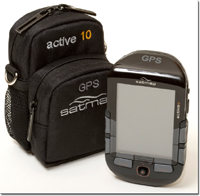


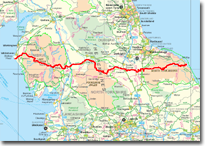 Just a quick post to let you know about the latest trip on offer. The English off-road c2c is a one of those 'must do' trips for mountain bikers, but there are a good few routes you could use. You won't find this exact route in the guide-books; the trails have been carefully chosen to replace some that have been dulled down with trails that give you the MTBers grin!
Just a quick post to let you know about the latest trip on offer. The English off-road c2c is a one of those 'must do' trips for mountain bikers, but there are a good few routes you could use. You won't find this exact route in the guide-books; the trails have been carefully chosen to replace some that have been dulled down with trails that give you the MTBers grin!
 Look out for a Bikeradar article in the next month or so by Ruth Schofield on a 1:1 day's skills coaching with
Look out for a Bikeradar article in the next month or so by Ruth Schofield on a 1:1 day's skills coaching with  I took a supply on a 7stanes trip the other week & they were liked by all. So here’s the
I took a supply on a 7stanes trip the other week & they were liked by all. So here’s the 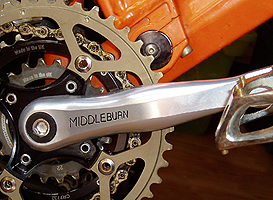 Cranks. Pedals one end, bottom bracket the other, 1 - 3 chainrings, make the bike go
Cranks. Pedals one end, bottom bracket the other, 1 - 3 chainrings, make the bike go